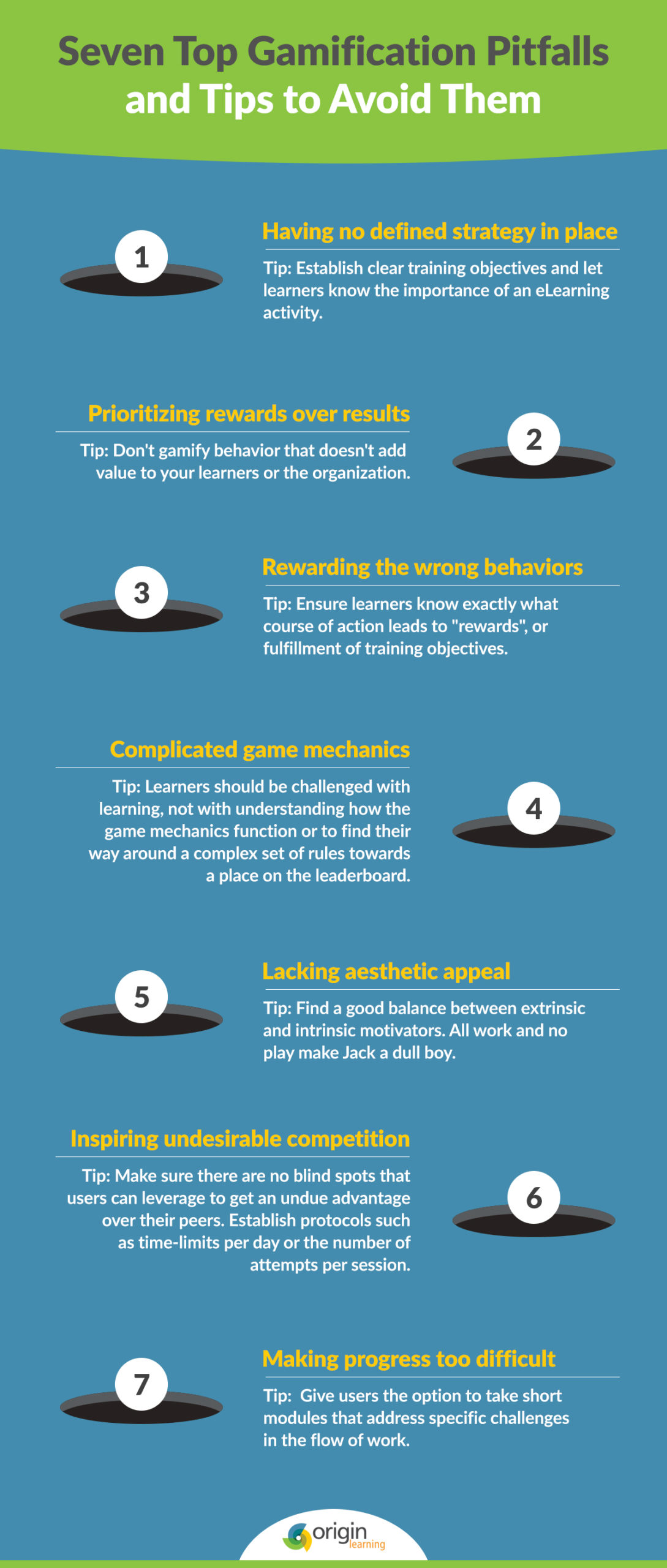Advancements in learning technology have led to the prevalent adoption of gamification for employee engagement. Gamification can improve motivation, increase cooperation among teams and improve completion rates of training programs. Effective gamification of corporate training requires careful examination of learner profiles and organizational objectives.

In this blog post, we explore seven gamification pitfalls when developing a corporate learning program and tips to avoid them.
Table of Contents
Pitfalls of Gamification to Avoid in Corporate Training
Having no defined training objectives
The true potential of gamification is achieved by effectively integrating it with an existing training program. However, it is vital to ensure that the preexisting strategy is sound. Performance is affected when objectives are unclear and the training strategy is flawed. Besides setting clear objectives for your learners, you should also establish the desirable behaviors to inspire through gamification (more on this in pitfall #3).
Tip: Establish clear training objectives and let learners know the importance of an eLearning activity. Set expectations and ensure your strategy is aligned to large training goals. Avoid open-ended goals such as “improve adoption”. Map out a trajectory of efforts and behaviors that will lead to desired training outcomes.
Prioritizing rewards over results
Rewards should be of value to your learners. Extrinsic rewards, such as badges and points, should not devalue the actual learning objectives. It must reinforce their efforts in the right direction, i.e., towards training goals. Choosing trivial rewards risks users placing rewards above results. For example, by offering badges to users that are not relevant to objectives. Employ game mechanics that align the desired behaviors with learning objectives.
Tip: Award badges/rewards for exhibiting task proficiency or to demonstrate the desired skillsets developed during a program. Don’t gamify behavior that doesn’t add value to your learners or the organization.
Rewarding the wrong behaviors
When implementing gamification elements, ensure you do not accidentally reward the wrong, or erratic, behavior. Learners should be able to clearly determine which behaviors lead to favorable outcomes and which do not.
This can be best understood through an experiment by the behavioral psychologist B.F. Skinner: When pigeons were put in a box with a button to push for food pellets, they did everything they could with the hope of a reward. The catch here was that the food pellets came in regular intervals and the button was just a decoy. What did the pigeons learn? To do whatever they did when the pellets first delivered, flapping wings and swinging beaks without understanding which behavior was being rewarded. The pigeons behaved as if there was a causal relationship between their behavior and the presentation of food.
Tip: Ensure learners know exactly what course of action leads to “rewards”, or fulfillment of training objectives.
Complicated game mechanics
The central purpose of gamification in L&D is to achieve desired learning outcomes through behavior change, acquisition of skills, and the completion of a course. Avoid complicated point systems or leaderboards that employ complex rules. Game mechanics should be simple and straightforward. Complex mechanics can demotivate learners and hinder the achievement of desired outcomes.
Tip: Establish rules simply and clearly. Learners should be challenged with learning, not with understanding how the game mechanics function or to find their way around a complex set of rules towards the leaderboard.

Lacking aesthetic appeal
Your gamified eLearning course needs to be visually appealing to attract learners’ attention and engagingly deliver the subject matter. As discussed in the previous points, game mechanics and clear learning objectives are important, but should not come at the expense of a poor visual appeal. Every facet of the gamified learning environment should communicate the core theme of the program. This recent study shows that aesthetic appeal and the feeling of having fun is of primary importance, as it affects user attitude and sustained use.
Tip: Find a good balance between extrinsic and intrinsic motivators. Aesthetic learning experiences can be extrinsically motivating to users but go only so far. The ability to perform a function better and faster are intrinsic motivators to sustain learning.
Inspiring undesirable competition
The social element of gamification can be greatly advantageous to encourage cooperation and motivation, however, balance is key. If your gamified program inspires too much competition amongst learners, it can manifest undesirable results.
One way to avoid this is by leveling the playing field. For example, when there is no cap on the time-limit in the learning program to achieve rewards, then the leaderboard will not exhibit equity of recognition. Learners that have more time to engage with the program will dominate the rewards and recognition far beyond their peers. This can lead the rest to lose interest and disengage with the program.
Tip: Competition and reward are closely related. Make sure there are no blind spots that users can leverage to get an undue advantage over their peers. Establish protocols such as time-limits per day or the number of attempts per session.
Making progress too difficult
Ensure that learners have the resources that they need to fulfill tasks, learn desired behavior, and win rewards. The difficulty of tasks should be in correlation to competency. Introduce levels to ensure that learners compete against peers with similar competency. If your module is too complicated, learners should have ready access to a prerequisite course that prepares them to tackle increasingly complex challenges. This ensures learners aren’t demotivated. Gamified environments can be integrated with skill assessment to determine the problem points of users. This information is invaluable to learning managers and product teams. When you find many learners struggling with the same challenges, create modules that address these.
Tip: Microlearning integrates seamlessly with gamification. Give users the option to take short modules that address specific challenges in the flow of work.
Effective integration of gamification can boost the performance of your corporate training programs. Gamification is a versatile tool to improve customer engagement, product adoption, employee motivation, sales success, and inspiring desirable change in learner behavior. The content development team at Origin Learning creates compelling learning experiences to advance training goals. We love leveraging gamification because it keeps training fun for users and in our experience, it often leads to better training outcomes.
Our gamified learning solutions are customized to fit the needs of your users and your organization. To learn more about gamification for your enterprise, write to us at info@originlearning.com
